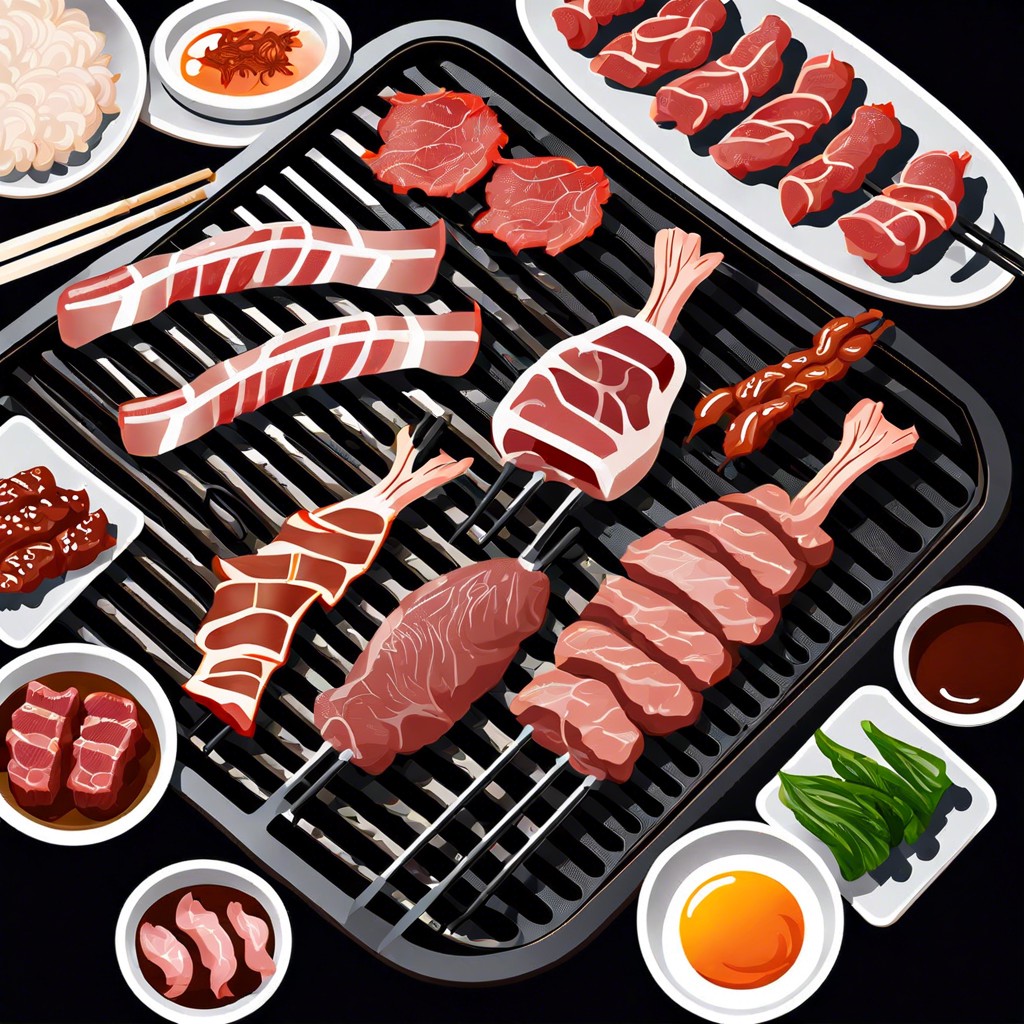Korean BBQ, a communal and interactive dining experience, features grilled meats that diners cook themselves at the table over gas or charcoal grills.
Key takeaways:
- Choose your meat: Bulgogi, Galbi, Samgyupsal, Dak Galbi, Daeji Bulgogi.
- Learn about different cuts of meat: Beef, pork, marination.
- Cooking the meat: DIY at the grill, flip and monitor doneness.
- Navigating Banchan: Side dish etiquette.
- Understanding restaurant service: Who grills the meat?
Choose Your Meat

Selecting the right proteins is crucial for a successful Korean BBQ experience, as they are the main event of the meal. Each option brings its own unique flavor and texture to the table:
- Bulgogi: Thinly sliced beef marinated in a sweet and savory sauce; tenderness is its hallmark.
- Galbi: Beef short ribs, often cut laterally; they offer a rich, meaty experience complemented by marination.
- Samgyupsal: Pork belly slices that bring a delightful fattiness, usually served without marinade to appreciate the pork’s natural flavors.
- Dak Galbi: Spicy marinated chicken for those who prefer poultry, it adds a kick to the selection.
- Daeji Bulgogi: Spicy pork that caters to aficionados of heat and complexity in their meal.
Each meat interacts with the grill differently. Thinner cuts cook quickly and absorb marinades deeply, while thicker cuts require more time on the heat, allowing diners to savor the gradual caramelization of natural sugars and fats. When choosing meats, consider variety to cater to all palates and the thrill of trying something new.
Learn About Different Cuts of Meat
Selecting the right cut can elevate your Korean BBQ experience substantially. Beef features prominently, with bulgogi (thinly sliced sirloin or tenderloin), and galbi (bone-in short ribs) being sought-after choices for their tenderness and marbling. Pork is not to be overlooked; samgyeopsal (pork belly) brings a satisfying, fatty richness that crisps beautifully on the grill.
When exploring the options, take note of marination. Bulgogi often comes in a sweet soy sauce-based marinade, enhancing its flavor and caramelization properties. Conversely, galbi may be served either marinated or plain, letting you savor the meat’s natural taste.
For health-conscious diners, dak (chicken) presents a leaner alternative without sacrificing flavor, especially when seasoned with a spicy, gochujang-based sauce.
Remember that thickness matters. Thinner cuts cook quickly and absorb marinades more deeply, offering an immediate burst of flavor, while thicker slices like chadolbaegi (beef brisket) deliver a more pronounced meaty flavor and require attention to achieve optimal doneness.
Cooking the Meat: DIY At the Grill
As you’re seated around a built-in table grill, it’s time to showcase your grilling prowess. With tongs in hand, place thinly sliced meats on the hot surface, ensuring they’re spread out for even cooking.
Flip the pieces once they brown – this happens quickly due to the thin cuts. Keep an eye on juicier options like pork belly; they may need extra time to achieve that desired crispness.
Engage in the interactive experience by monitoring doneness to your preference – a quick sear for tender bites or longer for a charred edge. Remember, the allure of Korean BBQ is in its fast-paced sizzle and the joy of cooking together.
Navigating Banchan: Side Dish Etiquette
Banchan, an array of Korean side dishes, is integral to the Korean BBQ experience and complements the grilled meats. When they arrive at your table, typically in small bowls, it’s considered polite to wait until everyone has been served before sampling. Share these dishes together rather than treating them as individual portions.
Always use the communal chopsticks or spoons provided to serve yourself, rather than your personal utensils, to maintain hygiene. While there’s no specific order in which you must try the banchan, enjoy them as palate cleansers or to add varying flavors and textures to your meal. It’s also customary to leave the banchan on the table rather than passing them around.
These dishes are meant to be refilled throughout the meal, so it’s perfectly acceptable to ask for more of your favorites.
Understanding Restaurant Service: Who Grills the Meat?
In the communal atmosphere of Korean BBQ, restaurant service style varies. At traditional establishments, servers may assist with the grilling process, attentively cooking and cutting meat at your table. This ensures that meats are cooked perfectly and allows diners to relax and enjoy their meal without the guesswork.
At modern or casual spots, the staff might provide an initial demonstration, leaving the rest of the cooking in your hands, which adds to the interactive experience. For first-timers, don’t hesitate to ask for assistance; staff are usually eager to guide you through the grilling process.
Regardless of who ends up manning the grill, it is customary to show appreciation for the service offered, as it is integral to the authentic Korean BBQ experience.